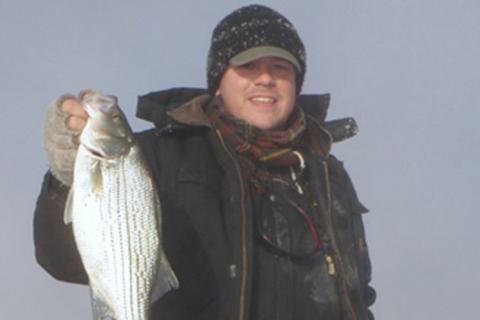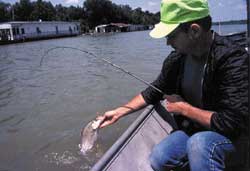
In spring, white bass seek tributaries of major reservoirs for spawning runs. It is during these spawning runs, when thousands of whites are concentrated in small streams, that most white bass are taken during the year. In fact, for some white-bass aficionados, there's no season but spring. When spawning runs end, so does the fishing.
 |
| White bass have small mouths — big baits won't catch them with any consistency. |
That's unfortunate, for winter is an excellent season for catching whites. Many anglers catch them in dam tailwaters by tightlining from the bank or wade fishing in the shallows a safe distance from the dam. Others fish lakes and rivers from boats, using a sonar unit to find whites schooling around deep-water sunken islands, river bars, long points and other structure. When fish are found, it's usually easy to entice them with a well-placed lure or bait.
![]() TIP: Shop all types of fishing gear at basspro.com
TIP: Shop all types of fishing gear at basspro.com
Fishing Baits & Lures
White bass feed on small baitfish like shad and minnows. Consequently, most are caught using live baitfish or artificial lures imitating that prey.
Of course, that takes in an astounding variety of baits — small live shad, live shiners, jigs, small spoons, small spinners, small crankbaits and other popular enticements like Gay Blades and tail spinners. Small is the key word here. White bass have small mouths, and big bait won't take them with any measure of consistency.
In my experience, you'll rarely go wrong using live minnows, lead head jigs or a combination of the two.
For minnows, use a sinker tied to the end of the line to drag the bait to the bottom where winter whites are usually found. The minnow is lip-hooked on a small, single hook attached to a dropper line tied a few inches above the weight.
Lead head jigs must be also have enough weight to carry them to or near the bottom. For shallow water, lighter jigs — 1/16 to 1/8 ounce — work well; in deeper or more turbulent water, some anglers go as heavy as 1/2 ounce. When using a jig/minnow combo, consider adding a #8 treble hook as a trailer. To do this, tie a short length of line to the bend in the jig's hook, and tie the treble hook on the other end. Hook a minnow through the lip with the jig hook, then hook one barb of the treble hook in the minnow's tail. This rig sounds complicated, but it helps nail soft-hitting winter white bass on the slightest nibble.
Deep Structure Fishing
During spring, summer and fall, white bass are nomadic, sometimes roaming for miles as they follow schools of shad and other baitfish. In winter, however, cold water reduces their metabolism and the need to feed. For a few weeks, the roaming urge is quelled, and whites gather in fairly stationary schools in deep water.
 |
| Sand bass this time time of year school around points, underwater islands and river bars. Sonar is a must for finding reservoir fish. |
In big deep reservoirs, they may be down 40 feet or more, usually holding in open water around some type of prominent underwater structure like a hump or fast-dropping point. The same behavior is observed on big rivers; look for white bass near deep structure like river-channel edges and plummeting holes at the mouths of tributaries. Sand structures like bars and flats are especially attractive, hence the common nickname "sandies." Rarely will whites be found where brush and big rocks cover the bottom. Smooth-bottomed open-water areas provide the habitat they prefer.
Invaluable equipment for fishing deep structure includes bottom-contour maps of the lake, marker buoys that allow you to stay near structure or schools of fish and, most important, a sonar fish-finding unit that will reveal structure as well as the fish themselves. Since white bass spend most of their time over a clean bottom, it's much easier to locate them with electronic gear than is the case with fish that live in dense cover. Check the spots where whites should be, and when you see some returns, mark the spot with a buoy and start fishing.
One of the best lures for these deep-water fish is a small jigging spoon worked vertically beneath the boat. Fish the spoon straight up and down. Jerk it hard, raising it 4 or 5 feet, and let it flutter back down on slack line. Most strikes come while the spoon is falling. And you probably won't feel the strike, but that's OK. When you jerk the spoon again, you'll set the hook. That's the reason for jerking it hard.
Another one of my favorite lures for deep-water whites is the Road Runner. Yes, most anglers see this lure as a crappie lure but this lure can be used for bass as well. The Road Runner lure can be cast and retrieved up and down points, over and around humps and along deep sand bars and flats. It has what I call a double whammy — the flash of a spinner and the seductive dance of a marabou or rubber-skirted jig all wrapped up in one deadly little package. Work the lure just above the bottom where the big sows lurk. Use a varied retrieve, sometimes fast, sometimes slow, sometimes smooth, sometimes jerky. Occasionally, it should fall to the bottom and be ripped upward again. All these shenanigans will usually be more than white bass can bear, and the flash of the little spinner whirling through the water just ahead of the twisting tail entices strikes from even the most finicky fish.
Yet another method of taking whites on deep winter structure is to troll with deep-diving lures, or better yet, to troll with downriggers and small jigs. Trolling covers a lot of water and will produce fish on those rare days when whites don't want to cooperate. Trolling may also be the best method for taking suspended white bass, fish holding at mid-depths between the surface and bottom. Suspended fish are generally hard to catch by casting or jigging.
White Bass Fish: Pre-Spawn Staging Areas
As winter draws to a close, water temperature climbs toward the mid-50s, and white bass begin heading upstream or uplake to searching for shallow spawning riffles. This migration begins well before the actual spawn, and progresses in stages as water and weather conditions change. During the journey, whites gather in huge concentrations in "staging areas," places that provide quick access between winter's deep haunts and spring's shallow spawning streams. The smaller males arrive first, followed a week or two later by the heavy egg-laden females.
 |
| Trolling is a superb way to take deep-schooling white bass. |
In large reservoirs fed by several small tributaries, staging areas will usually be in the upper third of the lake. That may still be a big spread of water, but for all practical purposes, every spawning-sized white bass in the lake will be there, making them significantly more concentrated. Most will be found in deep holes near mouths of tributaries with good current flow or along secondary creek channels in deeper water nearby. Creek/river channel junctions in these areas offer exceptional potential.
In big rivers, whites often stage and spawn below dams when their upstream migration is blocked. For this reason, tailwater fishing is outstanding throughout the late winter/early spring period.
The same lures and tackle used earlier will work when fishing these staging areas. But you can often use a faster presentation. As the water warms from the upper 40s through the low 50s, toward the ideal spawning temperature of 53 to 64 degrees, the fish become more aggressive. During prolonged periods of warmth, some fish will migrate 50 or 100 yards up a creek and stay in the same area until a cold front drives them back to deeper water. So fishing pools in the lower ends of spawning tributaries may prove very effective. In this situation, there's simply no limit as to how many whites can stack into a single pool.
Winter fishing isn't for everybody. For most of us, a warm fireplace is much more attractive than a frigid outing on a big, cold river.
If the fishing itch gets too intense to bear, though, give winter white bass a try. Fishing for these sassy panfish is a sure remedy for what ails you.
- 27666 views

